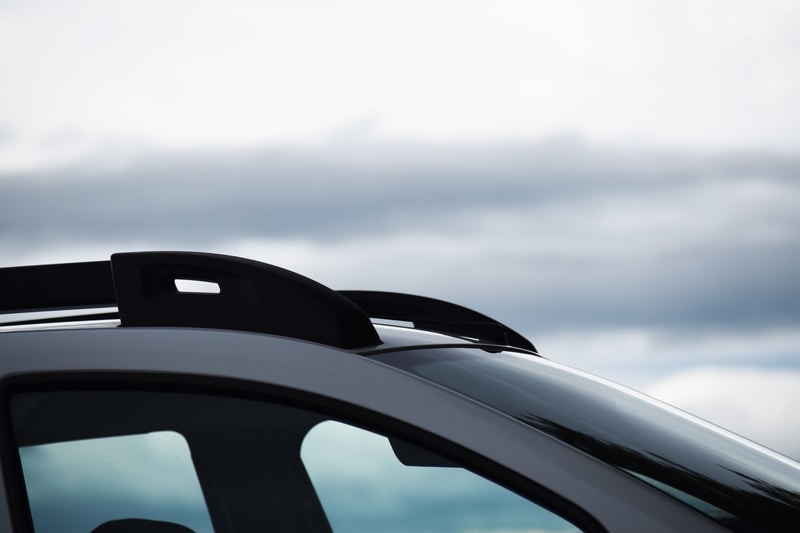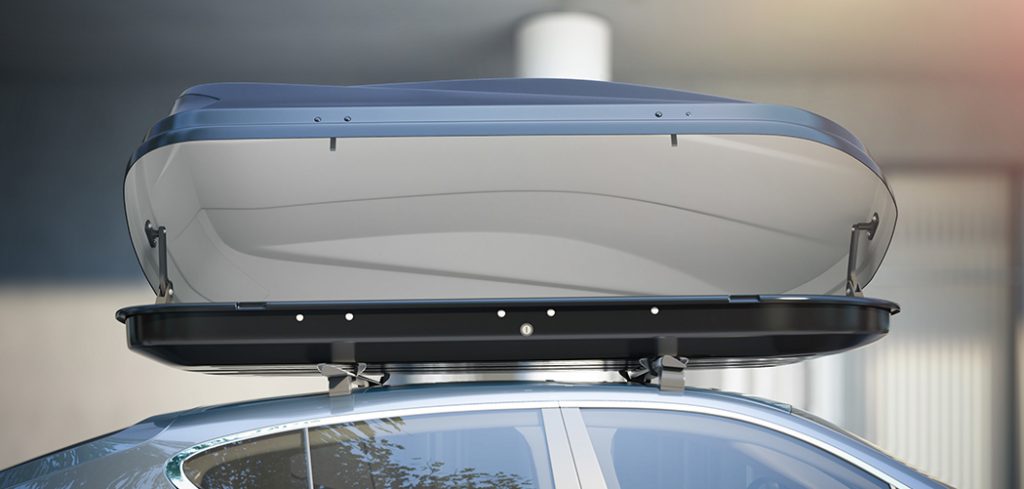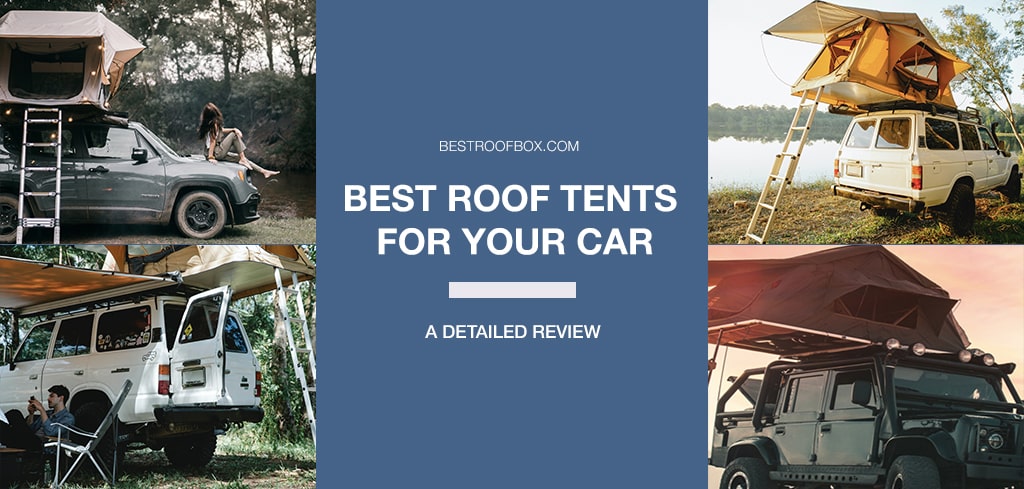We’ve all been there – you’ve loaded the car with everything but the kitchen sink and now, no matter how many times you pack and re-pack it, you still can’t see out of the rearview window and no one in the back seat can move!
A roof box is the answer to your overpacked car dilemma. Think of all the extra room you’ll have. Just make sure that your roof box is properly and safely fixed to your car.
In this guide, we’ll take you through how to fit a roof box to your car quickly, easily and safely.
Table of Contents
Key Takeaways
- Always check for roof boxes specifically for your car's brand and model
- Keep overhang to a minimum
- Know your options (roof cargo box vs. roof cargo bags)
- Positioning is also important
- Know your cargo box's limits
- Make full use of your cargo box's lock system
Do You Need Roof Bars for a Roof Box?
 Erm yes, roof bars are pretty vital to installing a roof box. A length of rope will not do. There needs to be a place for the box to bolt into on top of your car or van. If your car is a make and model that doesn’t come with roof box bars as standard, you can order a set and have them installed so that you can mount your roof box securely.
Erm yes, roof bars are pretty vital to installing a roof box. A length of rope will not do. There needs to be a place for the box to bolt into on top of your car or van. If your car is a make and model that doesn’t come with roof box bars as standard, you can order a set and have them installed so that you can mount your roof box securely.
Roof boxes are one of the most convenient ways to store your luggage while you’re on the road and they hold quite a bit of cargo. But, if they are installed incorrectly they can cause damage to your vehicle and your stuff is likely to end up scattered along the freeway.
Installing the box is simple enough but there are a few important things to take into account before you put the roof box on your car, including things like the weight capacity of the roof box bars.
Do Your Research
Don’t be tempted to buy the cheapest options when it comes to your roof box bars. There are no shortcuts here. Be careful to choose bars that can be used specifically on your vehicle’s make and model. If you don’t it will work against you in the long run. Be sure to do the research and find the right bars to fit your car securely.
Can a Roof Box Overhang?
 There can certainly be some overhang when a roof box is installed on a car but overhang should be kept to a minimum. Finding a roof box that will fit your vehicle exactly can be difficult, so getting one that overlaps an inch or two each side will be OK and is unlikely to cause you any problems.
There can certainly be some overhang when a roof box is installed on a car but overhang should be kept to a minimum. Finding a roof box that will fit your vehicle exactly can be difficult, so getting one that overlaps an inch or two each side will be OK and is unlikely to cause you any problems.
If there is a significant overage of more than a couple of inches on each side you could have some balance issues. You’ve got enough to contend with on the roads. A jerky ride due to a shift of weight on the roof would be a distraction. And frankly just damn dangerous.
If overhang is unavoidable, find a roof rack that is longer, not wider. Find a roof box that is designed to hold longer items. In this case, more support should be added to keep the bulk evenly distributed.
Also, and this should be pretty obvious, but your roof box should not interfere with any other road users. Don’t put a roof box designed for an Audi Q7 on a Mini Cooper.
You should be careful to avoid too much overlap at the back, especially if you are driving a hatchback or a car with a trunk that lifts up higher than normal. If there is more than an inch or two of overhang, the trunk can slam into it and cause damage to the exterior of the car.
You could end up smashing your rearview window, not something you want to be dealing with just before your eight-hour road trip. Give the hatch or trunk plenty of room to operate free of the box.
It’s a Balancing Act
Most importantly, keeping the luggage in your roof box balanced is vital. Buying a roof box that fits closely to the dimensions of the roof of your car will help with this. Pack the box carefully so that the weight is distributed evenly.
It’s a good idea to drive around the neighborhood a couple of times to get used to the feel of the car with the loaded roof box on it. Here’s a little experiment; where safe, hit the brakes a couple of times to initiate a shift in weight to see if you have any problems.
It is better to give it a test run so things can be moved around instead of having to pull over on the highway to make adjustments.
Do Roof Boxes Fit Any Roof Bars?

Most roof boxes will fit most roof bars. However, there are always exceptions to the rule. Long boxes that hold skis and other larger, slimmer pieces of equipment will need the extra support of additional bars.
Check Your Spec
Also, if you try to put a box on the roof of your vehicle that weighs a little more than the roof bars allow for, you might need to add another bar or two to add more stability.
Any extra roof bars will need to fit around the original rack or slide alongside so that the load is evenly distributed with the rack exactly where it should on the top of the car. The extra bars are for added safety and security and shouldn’t interfere with the original rack or bars.
If you are installing a roof rack or roof bars yourself, or your are replacing an old roof rack to use with a roof box you already have, do your research and make sure that the roof box fits. The holes for the bits and bolts need to line up or you might be creating more work and expense for yourself.
Roof Cargo Bags as an Alternative to Cargo Box

Consider using a cargo bag over a roof box. This could fix any issues you’re having with fit because the size and shape of a cargo bag can be manipulated to work correctly.
Follow Instructions
Always follow the instructions that come with your roof bars and roof box. From assembling your box to fitting the bars, it is imperative that you get it right. The last thing you want to do it cause a multi-vehicle pile up on the highway because you didn’t follow the instructions to the letter.
If you are unsure at any point, you should go back to the instructions and make sure everything is correct.
It is important to study the combination of roof bars and roof box that you have chosen for your car or van. The manufacturer of both your bars and box should have a list of compatible units that it is designed for.
They should also have the maximum weight load that the box and bars can take together. Keep this in mind when deciding which one to purchase so that you can travel safely and prevent damage to the top of the vehicle once the box and bars are mounted.
Will Roof Racks, Bars and Boxes Damage My Car?

If you follow manufacturer’s instructions to the letter, there should be very little or no damage to your car caused by the roof box or roof rack. Ignore the instructions at your peril – weight restrictions exist to prevent damage to your car.
Mind Your Backs
When you are packing your roof box, try and stick to the lower end of the maximum weight range as specified by the roof box manufacturer. And at this point it is worth saying that you should be careful too – roof boxes are bulky things and are hard for just one person to handle.
Having multiple hands on deck to place your box on the bars and attach it securely will also keep the car from being dented and scratched. Consult your roof box manual because the manufacturer may have also recommended a maximum speed limit when you’re driving with the box in situ. Some units can be pulled up and away from the car roof if you are driving at speed. If your roof box pops open or even comes away from the roof of the car, you need to be able to stop and fix it before you cause an accident.
When you attach your roof box to the roof bars, you should be careful how tightly it is screwed down. If it is too loose, it will shift on the bars and drag the rack along the roof with it. If it is too tight, it can damage the bars and the box.
Make sure to watch the video below on how to install your roof box to the roof bars the right way.

If your roof box becomes a permanent addition to your car and is kept out in the rain and snow it can cause the metal to rust onto the car, which could cause a blemish. Be certain to watch out for this and apply something that will help prevent this from happening.
If you do need to install aftermarket bars or racks to your vehicle because it was purchased without them, you will need to thoroughly clean the area where they need to be mounted. The area should be free of gunk and debris before the rack is assembled and securely fastened.
You also need to be aware that it is different when you have a box fitted on your vehicle. Don’t take going under a bridge or into a parking garage for granted. If you hit a low hanging beam you will most likely tear the roof box and even the bars or rack off the car and do quite a bit of costly damage to your vehicle. It sounds so obvious but just remember the extra height. It could cost you dearly.
How Far Apart Should the Roof Bars Be?

The rule of thumb when spacing roof bars apart is that the further apart they are, the harder it is for them to support the weight of the box. Most roof box manufacturers recommend that bars are spaced twenty-four inches apart at the most. Be aware that this standard applies to any crossbars that might go along with the rack that is currently in place.
While this is a good guideline for a standard box, you will need extra support for one that has been overstuffed or is carrying heavier cargo. As long as they will fit, adding another bar or two will help distribute the weight of the bulk that is riding on the roof.
You will want the box to be evenly supported from the front to the back so the bars should be spaced an equal distance from one another. Although most car boxes are made of hard plastic, you will want to avoid the chance of your roof box drooping and potentially scratching your paintwork. A cargo bag can also drop between the bars and touch the top of the vehicle. Having an even distribution of roof bars can keep this from happening.
Check your vehicle’s owners manual to find out what the maximum weight is that the top of the car can handle before mounting anything to the roof. Once that number is established, then you can decide how many bars will be needed to handle the box.
When that number is being calculated, always remember to factor in the rack itself and any extra bars that need to be put on also. They might be lightweight but they will still factor into the final weight count.
Consider the type of object that will be attached to the roof rack and compensate for the length, width, and weight of it. It is better to be safe and add more bars if needed then to have whatever is being carried damage the roof of the vehicle.
If you are unsure of whether you should stick with what you have, you can look for advice from specialist retailers. A professional will let you know what your options are and even help you prepare the car before the roof box is attached.
What's the Best Position for a Roof Box on a Car?
Spread the weight as evenly as possible to prevent any issues with weight on the top of the vehicle. If the bulk is too far forward or significantly in the back of the roof box, it could shift hard if you have to do an emergency stop and tug hard on the box.

This reaction could pull the rack up and away from the car and cause damage to the body of the vehicle. Mounting the bars and boxes correctly according to the manufacturer’s instructions can limit this. But to help avoid this situation even more, take extra care when packing your roof box.
Use your common sense – if it seems that the load is too heavy or it is difficult to redistribute the luggage, you might have to put the more awkward items in the trunk or on the backseat for the trip. To make the car more aerodynamic and encourage airflow around the box, it should be attached closer to the back of the automobile than the front.
And just think, the less drag on the car, the better it will be for gas consumption.
Safety Considerations
An overhanging roof box at the front of your car could impede your view and make driving your vehicle pretty dangerous. Having it fall over the side of the car could be a danger to others on the road. The design of the box conforms more to the back so it should be nudged either to the center or towards the rear.
However, you will need to keep in mind how far back you mount it so that the hatch has less chance of colliding with it. There might be just an inch or two between the back of the roof box and the glass of the hatchback.
This would also apply to the trunk lid. If the trunk hits the corner of the box it could cause a large dent and scuff the paint. Calculate how much over the box will be from the roof to the hatch or trunk and adjust accordingly. If they must touch, be aware each time the hatch is open to keep it from slamming the box.
Final thoughts
The information in this article is meant as a rough guide on how to fit a roof box to your car. You should always consult the instruction manual for your car, roof box, and roof bars carefully before installing, and reach out to the manufacturers of your products if you are still unsure.
With that said, fitting modern roof cargo carriers is pretty straightforward and with a little care, you’ll be off on your next adventure with all your gear in no time at all.




